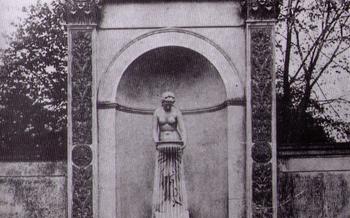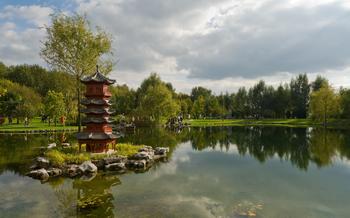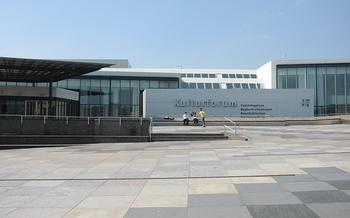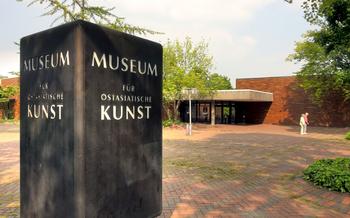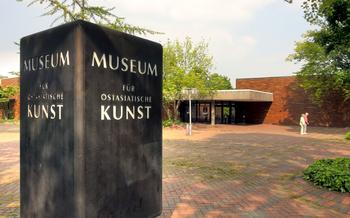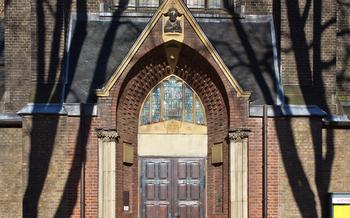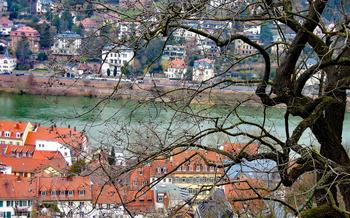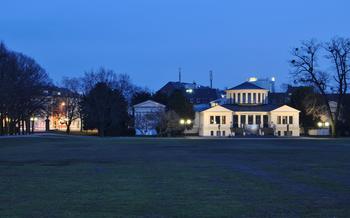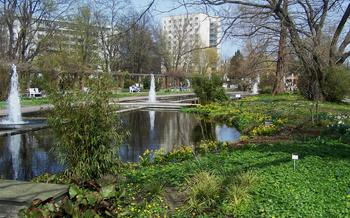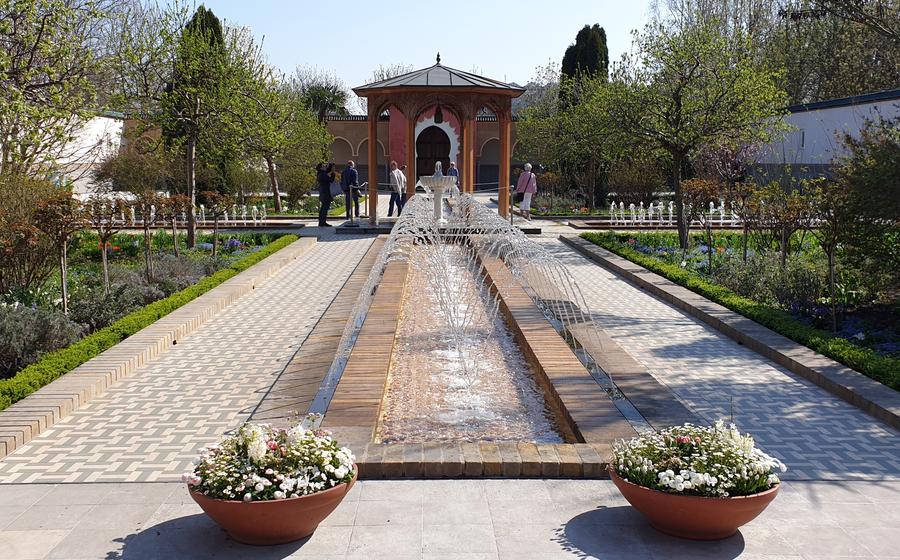
The Gardens of the World (Gärten der Welt) in Marzahn Hellersdorf
- The Chinese Garden
- The Italian Renaissance Garden
- The Japanese Garden:
- The Balinese Garden
- The Oriental Garden:
- The English Landscape Garden
- The Korean Garden:
- The Christian Garden:
- The Labyrinth Garden
- The Rose Garden
- The Playground:
- Events and Exhibitions
- The Restaurants and Cafes
The Chinese Garden
The Chinese Garden is a splendid example of traditional Chinese landscape architecture, designed to evoke the essence of harmony and balance between nature and humanity. Inspired by the classical gardens of Suzhou, it features intricate pavilions, arched bridges, and serene ponds, all arranged according to the principles of feng shui.
Walk through the Moon Gate, the traditional entrance to the garden, and immerse yourself in a world of tranquility and beauty. Stroll along winding paths that lead you past lush greenery, delicate rockeries, and cascading waterfalls. Admire the intricate carvings and colorful decorations that adorn the pavilions and bridges, each telling a story from Chinese mythology or history.
The garden's meticulously manicured plants and flowers add to its charm and symbolism. Peach trees, representing longevity, bloom in the spring, while lotus flowers, symbolizing purity and enlightenment, grace the ponds. Ancient Chinese scholars believed that gardens were microcosms of the universe, and the Chinese Garden at Gärten der Welt beautifully embodies this concept.
The Italian Renaissance Garden
The Italian Renaissance Garden is a testament to the grandeur and elegance of the Italian Renaissance period. Its meticulous design and intricate details transport visitors back in time to the era of lavish gardens and architectural wonders.
-
Fountains and Sculptures: The garden is adorned with magnificent fountains and sculptures that showcase the artistic prowess of the Renaissance masters. The centerpiece of the garden is the Grand Fountain, a towering masterpiece with intricate carvings and cascading water streams. Other sculptures depict mythological figures, animals, and scenes from Roman history, bringing a sense of grandeur and artistry to the garden.
-
Terrace and Pergola: A beautiful terrace offers a panoramic view of the garden and the surrounding landscape. It is the perfect spot to relax and soak in the beauty of the surroundings. A pergola, covered with climbing roses and fragrant vines, creates a shaded walkway that leads to different parts of the garden, adding a touch of romance and charm.
-
Themed Areas and Statues: The garden is divided into themed areas, each representing a different aspect of the Renaissance era. One section features a herb garden, where visitors can explore the medicinal and culinary uses of various herbs. Another section is dedicated to roses, with a variety of colors and fragrances that fill the air with their sweet scent. Statues of famous Renaissance figures, such as Dante, Petrarch, and Michelangelo, adorn the garden, paying homage to the cultural icons of the era.
The Japanese Garden:
The Japanese Garden at the Gardens of the World is a serene and tranquil oasis, inspired by the principles of Zen Buddhism. Designed to promote contemplation and inner peace, this garden features a harmonious blend of natural elements, carefully arranged to create a sense of balance and tranquility.
Upon entering the Japanese Garden, visitors are greeted by a traditional tea house, inviting them to pause and savor the moment. The tea house is surrounded by a meticulously manicured Zen garden, featuring carefully raked gravel and strategically placed rocks, symbolizing the impermanence of life and the beauty of simplicity.
The centerpiece of the Japanese Garden is a series of interconnected ponds, fed by gentle waterfalls that cascade over moss-covered rocks. The water features add a sense of movement and tranquility to the garden, creating a calming and meditative atmosphere.
The plant life in the Japanese Garden is carefully selected to enhance the overall aesthetic and symbolism of the space. Cherry blossom trees, a symbol of beauty and transience, bloom in vibrant pink during the spring, while maples, with their fiery red leaves, add a touch of color in the autumn. Azaleas, camellias, and irises provide pops of color throughout the year, creating a vibrant and ever-changing landscape.
The Balinese Garden
The Balinese Garden is a tropical paradise, transporting visitors to the lush landscapes of the Indonesian island of Bali. Step into this garden, and you'll be greeted by an explosion of vibrant colors, exotic plants, and intricate stone structures that reflect the rich cultural heritage of Bali.
The Oriental Garden:
The Oriental Garden, situated within the Gardens of the World, invites visitors to a realm of tranquility and Eastern aesthetics. Drawing inspiration from traditional Chinese architecture, the garden is characterized by its exquisite pagodas, arched bridges, and serene water features.
Strolling through this enchanting space, you'll encounter a diverse collection of bonsai trees, carefully cultivated and pruned into intricate shapes. These miniature masterpieces, representing centuries of tradition, showcase the patience and skill of their dedicated caretakers.
Amidst the lush greenery, you'll discover water elements and rock gardens, essential components of Eastern garden design. These elements evoke the balance and harmony of nature, creating a soothing and meditative atmosphere.
Whether seeking a moment of contemplation or simply admiring the beauty of the surroundings, the Oriental Garden offers a unique blend of cultural heritage and natural serenity. Immerse yourself in the tranquility of this enchanting space and let the spirit of the East envelop you.
The English Landscape Garden
The English Landscape Garden is a testament to the beauty and serenity of nature. Rolling hills and meadows, reminiscent of the English countryside, create a picturesque landscape that invites visitors to wander and explore. A serpentine pond, fed by a cascading waterfall, adds a touch of tranquility to the garden. Visitors can stroll along the winding paths, admiring the lush greenery and colorful blooms, and soak in the romantic and picturesque atmosphere that this garden exudes.
The Korean Garden:
The Korean Garden, situated within the Gardens of the World, reflects the rich traditions and aesthetics of Korean culture. This beautifully landscaped space showcases traditional Korean architecture, Bonsai, and Pine trees, along with various cultural symbols and elements.
Korean Architecture:
The Korean Garden features traditional Korean buildings, including a pavilion with intricate roof designs and wooden structures. These architectural elements add authenticity and charm to the garden, providing visitors with a glimpse into Korean architectural heritage.
Bonsai and Pine Trees:
Bonsai, an ancient art form, is prominently displayed in the Korean Garden. These meticulously pruned and shaped miniature trees represent patience, harmony, and balance. The garden also features lush Pine trees, which hold significant symbolism in Korean culture, representing strength, resilience, and longevity.
Cultural Symbols and Elements:
The Korean Garden incorporates various cultural symbols and elements that reflect Korean heritage. Stone lanterns, representing enlightenment and guidance, are strategically placed throughout the garden. Traditional Korean symbols, such as the Taegeuk (yin-yang symbol) and the Sam Taegeuk (three-legged crow), are also featured, adding a touch of cultural depth to the garden's design.
The Korean Garden serves as a beautiful representation of Korean culture, offering visitors a glimpse into the nation's traditions, aesthetics, and symbolism. Explore this tranquil space to appreciate the unique blend of architecture, Bonsai, Pine trees, and cultural elements that make the Korean Garden a captivating destination within the Gardens of the World.
The Christian Garden:
The Christian Garden, situated within the Gardens of the World, serves as a place for spiritual contemplation and reflection. This serene space is meticulously designed with biblical symbolism and themes, inviting visitors to explore the Christian faith's rich history and traditions.
The centerpiece of this garden is the Garden of Eden, a symbolic representation of the biblical paradise. Here, visitors can admire a variety of plants mentioned in the Bible, including apple trees, fig trees, and roses. The garden's design features winding paths that lead visitors through different sections, each representing a significant aspect of the Christian faith.
Visitors can find solace and inspiration in the chapel, a tranquil space for prayer and meditation. The chapel's interior is adorned with beautiful stained glass windows depicting biblical scenes, creating a sense of awe and reverence. The surrounding area offers peaceful seating areas where visitors can sit, reflect, and connect with their spiritual side.
The Labyrinth Garden
The Labyrinth Garden at the Gardens of the World is a mesmerizing and enigmatic attraction that invites visitors to explore its intricate pathways and discover hidden secrets. Inspired by ancient symbolism, the labyrinth is designed with winding paths that lead to a central point, creating a sense of mystery and exploration. As you navigate through the maze-like garden, you'll encounter tall hedges that form the labyrinth's walls, creating a secluded and contemplative atmosphere. The labyrinth symbolizes the journey of life, with its twists and turns representing the challenges and choices we face along the way. Visitors can wander through the labyrinth, taking time to reflect on their own life's journey and seeking inner peace and clarity. It's a unique and thought-provoking experience that encourages introspection and self-discovery.
The Rose Garden
The Rose Garden at the Gardens of the World is a haven for rose enthusiasts and nature lovers alike. With over 10,000 roses from around the world, this fragrant and colorful oasis is a delight to the senses. The roses are arranged in themed areas, showcasing different varieties, colors, and fragrances. Visitors can wander among the rows of roses, admiring the vibrant blooms and inhaling the sweet scent that fills the air. The garden also features sculptures and seating areas, providing a place to relax and enjoy the beauty of the roses. Whether you're a rose enthusiast or simply looking for a peaceful and fragrant escape, the Rose Garden at the Gardens of the World is a must-visit.
The Playground:
Amidst the tranquil beauty of the Gardens of the World, a vibrant and joyful space awaits young adventurers—the playground. Designed to ignite imagination and encourage active play, this dedicated area offers a variety of exciting structures that cater to children of all ages.
From the exhilarating slides that promise thrilling descents to the classic swings that provide a gentle, swaying motion, there's something for every child to enjoy. Climbing enthusiasts will delight in scaling the sturdy frames, challenging their physical abilities and reaching new heights.
The playground is meticulously crafted to ensure both safety and fun. Soft, shock-absorbent surfaces surround the equipment, providing a secure environment for kids to romp and explore. The colorful designs and playful motifs add a touch of whimsy, creating a captivating atmosphere that draws children in.
Whether seeking a respite from the tranquil gardens or simply looking for a place for the little ones to burn off some energy, the playground at the Gardens of the World is the perfect destination. It offers a harmonious blend of entertainment and education, allowing children to engage in imaginative play while fostering their physical and social development.
As parents relax and soak in the serene surroundings, they can find solace in knowing that their children are having an unforgettable experience in a safe and stimulating environment. The playground at the Gardens of the World is a true haven for families, where cherished memories are created amidst the beauty of nature.
Events and Exhibitions
Throughout the year, the Gardens of the World host a variety of events and exhibitions that add to the visitor experience. From seasonal festivals and flower shows to cultural performances and workshops, there is always something new to see and do.
Seasonal Events and Festivals:
The Gardens of the World come alive during special events and festivals that celebrate different cultures and traditions. During the spring, the Cherry Blossom Festival showcases the beauty of the Japanese cherry trees in full bloom, while the Summer Festival offers a vibrant celebration of music, dance, and traditional food from around the world.
Flower Shows and Garden Exhibitions:
The gardens also host regular flower shows and garden exhibitions that showcase the horticultural expertise of the gardeners and provide inspiration for visitors. The International Garden Festival, held annually, features innovative garden designs from around the world, while the Rose Festival celebrates the beauty and diversity of roses from different regions.
Cultural Performances and Workshops:
The Gardens of the World offer a platform for cultural performances and workshops that showcase the rich traditions of the countries represented in the gardens. Visitors can enjoy traditional music, dance, and theater performances, as well as participate in workshops on topics such as ikebana, origami, and Chinese calligraphy.
The Restaurants and Cafes
To complement the visual and cultural feast that the Gardens of the World offers, visitors can also indulge in a culinary adventure with several restaurants and cafes located within the premises. Whether you prefer to savor international cuisine or opt for refreshing beverages, these dining options have something for everyone.
The Restaurant im Chinesischen Garten delights visitors with authentic Chinese cuisine, offering a taste of the Orient amidst the serene atmosphere of the Chinese Garden. Enjoy a range of traditional dishes, aromatic teas, and dim sum while surrounded by the garden's tranquil landscapes.
For a Mediterranean experience, the Restaurant im Italienischen Renaissancegarten offers a menu inspired by Italian culinary traditions. Indulge in pasta, pizza, and other Italian specialties while enjoying the stunning views of the Renaissance Garden's fountains, sculptures, and terraces.
If you seek a quick bite or a refreshing drink, the Café am See is an excellent choice. With its location by the picturesque lake, this cafe offers a variety of snacks, cakes, and beverages, providing a perfect spot to relax and soak in the beauty of the surroundings.
For those seeking a unique dining experience, the Restaurant im Balinesischen Garten introduces the flavors of Indonesia. Immerse yourself in the lush greenery of the Balinese Garden while savoring traditional Indonesian dishes, complemented by the sounds of traditional music.
Whether you choose to enjoy a full meal or a light snack, the restaurants and cafes at the Gardens of the World offer a culinary journey that complements the overall experience, providing visitors with a chance to relish delicious food amidst beautiful surroundings.
